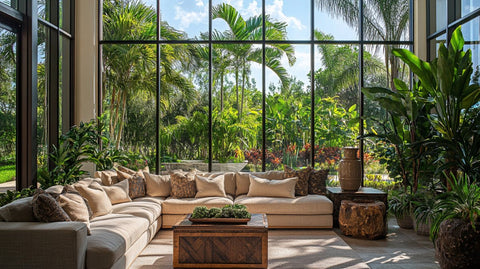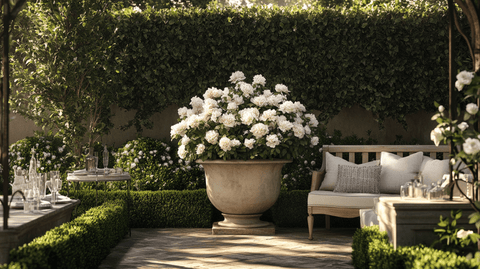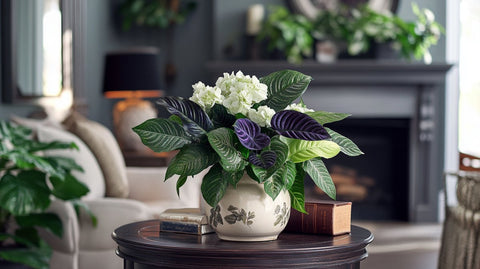Introduction
Southwest Florida (SWFL) is a captivating region, celebrated for its stunning landscapes, diverse flora, and rich ecological tapestry. Known for its warm subtropical climate, SWFL offers a unique environment that supports a wide variety of plant life, making it a paradise for gardening enthusiasts and conservationists alike. It's crucial to understand the local flora not only to enhance your garden’s beauty but also to contribute to environmental sustainability by supporting local wildlife. Did you know that the Adonidia Palm, often referred to as the 'Christmas Palm,' is a popular ornamental species here, due to its small stature and festive appearance, making it ideal for both residential landscapes and commercial projects?

The Unique Climate of Southwest Florida
Defining the SWFL Climate
Southwest Florida’s climate is characterized by its subtropical nature, featuring mild winters and hot, humid summers. This distinct climatic condition provides an environment where both tropical and temperate flora can flourish. The region’s annual rainfall average is approximately 55 inches, predominantly occurring in the summer months, creating a perfect breeding ground for a wide range of plant species.
Implications for Plant Life
The characteristics of the SWFL climate have significant implications for what grows well in the region. The high humidity and seasonal rains support a verdant, lush growth pattern. However, plants here must also be drought-resistant to endure occasional dry spells. As such, many native species have adapted with deep root systems or leathery leaves to conserve water.
Exploring Native Plants
Benefits of Native Flora
Utilizing native plants in gardening and landscaping offers numerous benefits. These plants are better adapted to the local soil and climate conditions, requiring less irrigation and fertilization. This makes them not only more environmentally friendly but also cost-effective. Furthermore, native plants provide essential habitats and food sources for local wildlife, supporting a biodiverse ecosystem.

Key Native Plants of SWFL
Cabbage Palm (Sabal palmetto)
The state tree of Florida, the Cabbage Palm, is a common sight in SWFL. Known for its resilience, it withstands hurricanes and thrives in poor soil. The palm offers shelter and food for wildlife, and its fibrous trunk can be used in traditional crafts.
Firebush (Hamelia patens)
This vibrant plant is a favorite among gardeners for its fiery flowers that attract hummingbirds and butterflies. The Firebush is drought-tolerant and thrives in the sandy soils typical of SWFL, making it a stunning and sustainable garden choice.
Popular Ornamental Plants
The Iconic Adonidia Palm
If you’re seeking to bring a tropical touch into your garden or landscape, look no further than the Adonidia Palm. Its manageable height and minimal maintenance requirements make it a top choice for landscape designers. Often planted in groups for dramatic effect, this palm is perfect for adding vertical interest to your garden composition.
Agapanthus: The Lily of the Nile
Known for its stately floral clusters and strap-like leaves, the Agapanthus is another magnificent ornamental plant that suits the SWFL climate. Its ability to withstand drought conditions and its striking blue or white blooms create an enchanting display that can uplift any garden space.
Xeriscaping: Water-Wise Gardening
Principles of Xeriscaping
With water conservation becoming increasingly important, xeriscaping offers a sustainable gardening solution. This approach involves using drought-tolerant plants and efficient irrigation designs to minimize water use. Ideal for SWFL’s periods of drought, xeriscaping emphasizes careful plant selection, soil improvements, and strategic planning.
Agave: The Perfect Plant for Xeriscapes
The Agave plant is a prime candidate for xeriscaping due to its hardy nature and minimal water requirements. Available in a variety of shapes and sizes, such as the Caribbean Agave and Variegated Agave, these architectural plants add a striking element to any xeriscaped garden.

Supporting Local Wildlife
Creating Habitats
SWFL’s native plants play a crucial role in providing food and shelter for indigenous fauna. By incorporating native and other suitable species into your garden plan, you can support local bird populations, invertebrates, and other wildlife, effectively contributing to the area’s ecological balance.
Choosing Wildlife-Friendly Plants
Consider incorporating plants such as the Wild Coffee (Psychotria nervosa) or Coontie (Zamia integrifolia) to attract pollinators and birds. These plants not only offer aesthetic appeal but also contribute to the garden’s ecological integrity.
Exploring Plantology’s Offerings
A One-Stop Shop for Plant Enthusiasts
At Plantology, we are dedicated to providing a comprehensive selection of both native and exotic plants tailored for the SWFL climate. Our offerings, such as the Aglaonema Silver Bay and Alexander Palm, are curated to ensure success in your gardening endeavors.
Enhancing Your Garden with Plantology
Whether you’re seeking the elegance of Adonidia Palms or the distinctive look of the Blue Agave, Plantology ensures a seamless shopping experience with expert guidance and high-quality plant selections. Visit us at our website to start transforming your garden today.
Conclusion
Southwest Florida’s unique climate presents an opportunity to cultivate a garden that is not only beautiful but also sustainable and wildlife-friendly. By understanding the characteristics of local plants and embracing practices like xeriscaping, you can create a thriving oasis. Plantology is here to support and inspire your gardening journey, providing the right plants and resources to help you succeed. Dive into the world of SWFL flora with us and make your garden a testament to the region's natural splendor.
``` This HTML document provides structured content about the diverse flora of Southwest Florida, encouraging readers to integrate sustainable practices and promoting Plantology's products and expertise in the process.Deep Dive into Native Flora

Pine Lily (Lilium catesbaei)
The Pine Lily is another native gem that deserves attention. This vibrant plant displays striking orange-red flowers with elegant recurved petals. It thrives in the flatwoods and pine uplands of SWFL, blooming primarily from July to September. Apart from its aesthetic appeal, the Pine Lily is crucial for local pollinators, providing nectar and serving as a habitat for various insects. Additionally, its ability to grow in wet and dry conditions makes it a resilient choice for native plant enthusiasts.
Saw Palmetto (Serenoa repens)
Saw Palmetto is a hardy plant native to SWFL, widely recognized for its fan-shaped leaves and creeping trunk. It is a drought-resistant species often found in sandy soils. Besides its decorative foliage that adds texture to landscapes, Saw Palmetto plays an important ecological role. Its berries are a critical food source for wildlife, including the Florida black bear and numerous bird species.
Annuals and Perennials: Adding Seasonal Color
Vibrant Annuals for Year-Round Color
Annuals are an excellent way to ensure a pop of color in your garden throughout the year. In SWFL, varieties like Marigold (Tagetes), Zinnia (Zinnia elegans), and the ornamental Sunflower (Helianthus annuus) thrive beautifully. These plants quickly establish themselves and produce rich blooms that attract beneficial insects and pollinators.
Perennials for Longevity and Beauty
Perennials, such as the Blanket Flower (Gaillardia pulchella), deliver long-lasting beauty and resilience in SWFL gardens. Known for their bright yellow and red blooms, Blanket Flowers are drought-tolerant and can thrive in poor soils. Their blooms continue to attract butterflies, lending added vibrancy and motion to garden spaces.
Soil and Landscaping Considerations

Soil Composition and Amendments
The sandy soils typical of SWFL have specific considerations for gardening. While they offer excellent drainage, they tend to be low in nutrients. To enrich your garden soil, organic amendments such as compost, manure, or peat can be incorporated to improve fertility and moisture retention. Regular testing of soil pH and nutrient levels will further guide appropriate amendments and fertilizer usage.
Landscaping Techniques That Complement the Environment
Strategic landscaping techniques, such as mulching and creating raised garden beds, enhance plant growth by retaining moisture and reducing weed competition. Mulching with organic materials, like bark or wood chips, not only conserves water but also enriches the soil as it breaks down.
Integrative Pest Management
Natural Pest Control Options
Integrative Pest Management (IPM) is a sustainable approach to controlling garden pests by using environmentally friendly techniques. Companion planting, such as marigolds with vegetables, can naturally repel harmful insects. Additionally, introducing beneficial insects like ladybugs and predatory beetles helps keep pest populations in check without using chemical pesticides.
Encouraging Biodiversity
Promoting a biodiverse garden helps maintain ecological balance and control pests naturally. By planting a variety of species and avoiding monocultures, you create an environment where pests have fewer opportunities to thrive unchecked. Allowing hedgerows to grow and maintaining dense plantings can attract birds and insects that are natural predators for garden pests.
Community and Cultural Significance
Traditional Uses of Native Plants
Many native plants in SWFL have been used historically by indigenous tribes for their medicinal properties and practical applications. The Seminole and Miccosukee tribes, for instance, utilized the roots of the Coontie plant to produce flour and various crafts. Recognizing and respecting these traditional uses enriches our appreciation for native flora and their roles beyond decorative purposes.

Strengthening Community Ties through Gardening
Gardening in SWFL offers a platform for community building and educational opportunities. Community gardens and local workshops foster connections among residents, provide food security, and promote sustainable practices. Participating in these initiatives encourages the sharing of knowledge and supports local biodiversity conservation efforts.
Future of Gardening in Southwest Florida
Challenges and Innovations
As climate change continues to impact weather patterns, SWFL faces new challenges in maintaining healthy landscapes. Innovations in water-saving technologies, such as drip irrigation systems and smart sprinklers, help gardens endure harsh climates. Climate-resilient plant breeding also plays a role in introducing new species engineered to adapt to shifting environmental conditions.
Inspiring the Next Generation
Educating the next generation about the significance of plants and ecosystems is vital. Schools across SWFL can integrate gardening projects into their curriculums, encouraging students to engage with nature from an early age. By fostering an understanding of sustainable practices and environmental stewardship, we can inspire young gardeners to carry forward these values.
Plantology’s Vision for SWFL Gardens
Commitment to Sustainability
Our mission at Plantology is to encourage and enable sustainable gardening practices throughout Southwest Florida. We aspire to be a resource for communities by providing information, workshops, and access to sustainable products. Our goal is to make environmentally responsible gardening accessible to everyone, from beginners to seasoned gardeners.
Continuing the Legacy of SWFL’s Natural Beauty
We believe every garden has the potential to be a sanctuary that reflects the natural beauty of SWFL. Through careful plant selection and thoughtful design, anyone can create a landscape that embodies the spirit of Florida’s flora. Join us at Plantology in embracing sustainability and enhancing the ecological richness of our region.

Conclusion: A Flourishing Future
Gardening in Southwest Florida offers an opportunity to cultivate spaces that are not only visually stunning but also ecologically responsible. By embracing native plants, practicing water-wise landscaping, and fostering a deep connection to our region's rich botanical heritage, every gardener can contribute to a flourishing future. Plantology is here to guide and support you on this journey, helping you create a garden that harmonizes with the natural world and stands as a testament to the enduring beauty and resilience of SWFL.






























Comments (0)
There are no comments for this article. Be the first one to leave a message!